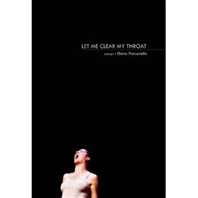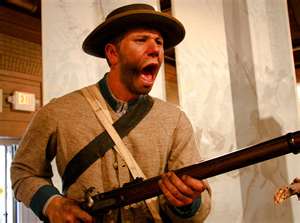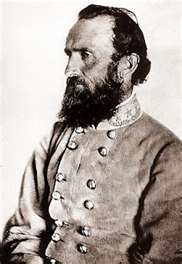Rebel Yell Is Not Just a Bourbon
When the inexhaustible Stars and Bars debate rekindled due to removal of some replica battle flags at Washington and Lee, I watched out my office window as the unreconstructed partisans paraded their Confederate colors in front of the building VMI professor Stonewall Jackson briefly called home. On special occasions, like the birthday of Robert E. Lee (a date shared with Dolly and Poe), they came out in force and serenaded the neighborhood with “Dixie” and “I Am a Good Old Rebel.” Passing supporters would honk their truck horns or shout encouragement, but I was puzzled by the absence of any attempt at the legendary Rebel Yell.
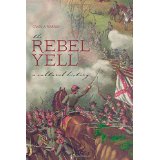 I wondered why, other than possible local ordinances, what had once been such a popular mode of regional expression was missing in action, and now Craig A. Warren has offered an explanation and a lot more in his soon-to-be-released and perhaps-definitive study The Rebel Yell: A Cultural History (Alabama, 2014), in which he chronicles the history, myths, aural analyses, associations and ultimate faded fate of the battle cry (which troops in homespun gray or butternut also used at celebrations and during prison camp baseball games). It’s a fascinating, if specialized, account and well worth the afternoon it took me to read its 162 pages of primary text and not a few of the numerous footnotes, which are substantive in their own right.
I wondered why, other than possible local ordinances, what had once been such a popular mode of regional expression was missing in action, and now Craig A. Warren has offered an explanation and a lot more in his soon-to-be-released and perhaps-definitive study The Rebel Yell: A Cultural History (Alabama, 2014), in which he chronicles the history, myths, aural analyses, associations and ultimate faded fate of the battle cry (which troops in homespun gray or butternut also used at celebrations and during prison camp baseball games). It’s a fascinating, if specialized, account and well worth the afternoon it took me to read its 162 pages of primary text and not a few of the numerous footnotes, which are substantive in their own right.
Warren offers information and speculation on the life of the yell from cacophonous battlefield to a Louisa May Alcott novel to reunions of veterans, analysis of the many audial representations of the barbaric yawp. He cites and compares the many memories of the yell from war survivors who were asked about it later, and he opens up the arguments about the many possible origins of the shout Shelby Foote called “a rolling wave of sound” (Cherokee, fox hunters, the “flocks of raucous birds” Greek hoplites simulated and more). Then he has a go at the myths, such as the twisted history that credits Stonewall’s command to “yell like furies” at Manassas: turns out the yell predates that fight by months. And who wouldn’t want to know of the many sites where the cry later echoed, Iuka to San Juan Hill?
What we should have all guessed long ago but were – most of us – too legend-smitten to realize is that different rebels at different places and times were bound to utter various noises, as the yell(s) had no recognizable pitch pattern or rhythm, rhyme or lexical sequence. Improvisation was the name of the game, so it was a wholly unpredictable pandemonium of sound that possessed such terrifying and liturgical power.
Warren also reveals the sometime-unfortunate results for the yellers. For instance, in the midst of all that black powder smoke, a unit’s exact deployment might be hard to determine, but once the ranks lifted their voices, their position might be clear enough to attract artillery fire. On occasion, maybe a whisper would have been wiser, if less provocative and adrenalin-jolting.
Among the fascinations Warren presents are the descriptions of the cry from line soldiers (Ambrose Bierce: “ugliest sound that any mortal ever heard”) or a Wisconsin veteran – my favorite – who recalled in 1909 the “corkscrew sensation that it sends down your backbone,” to civilian spectators and others who were not present at all and had it second or third hand (Stephen Crane: “prolonged pealings” of voice). Suffice it to say that the demon rasp conferred nerve, gave heart to the yellers, who were proud that their cry was not the regular and rhythmic chant of the yellees, their “factory Yankee” adversaries, who were in turn proud that they didn’t put people in mind of wild animals. Though much is in dispute, no one ever said the yell was mellifluous.
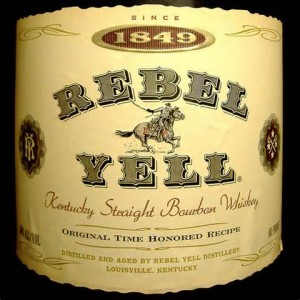 In the business arena: the wheated bourbon brand Rebel Yell, according to Warren, claims 1849 as its date of origin, but in fact the label (complete with sabre-wielding Confederate cavalryman at full gallop) was first marketed in 1936 by Stitzel-Weller of Louisville. Evidently some emotions had to be allowed to cool, others to rekindle before the yell could be commodified with impunity.
In the business arena: the wheated bourbon brand Rebel Yell, according to Warren, claims 1849 as its date of origin, but in fact the label (complete with sabre-wielding Confederate cavalryman at full gallop) was first marketed in 1936 by Stitzel-Weller of Louisville. Evidently some emotions had to be allowed to cool, others to rekindle before the yell could be commodified with impunity.
I won’t even try to recount the controversy (fueled by no less a light than Foote) that there was a particular “melody” to the rebel yell, and that it was lost when the last practitioners and their pupils had all gone on to a sweeter demesne. But that’s another chapter worth reading.
The most intriguing discussion in the volume for me involved the way that the yell gave way to the Stars and Bars as the signature of unreconstructed states’ righters. It transpired pretty suddenly when the Dixiecrat (rogue Southern Democrat) Party was formed in Birmingham in July of 1948. “The voice of the Confederacy,” which had become an historical oddity, gave way to a symbol that seemed more bellicose and reminiscent of a slave-holding society, given the general associations of “flag waving.” Make no mistake about it, the Dixiecrats knew what they were doing, and “heroic heritage” didn’t play much of a role. The flag was, as Warren quotes John Coski’s The Confederate Battle Flag: America’s Most Embattled Emblem (Harvard, 2005): “the chosen symbol of people dedicated to defending states’ rights as a means to preserve a social order founded upon white supremacy.” That’s the next book in this category I want to read.
So it turns out that Lexington’s shaggy flaggers are au courant in their expression of Old South revivalism. Though for a century the much disputed and often revered Southern scream was the dominant symbolic expression of the Lost Cause, the visible battle flag (easily displayed on private property, bumpers or as body ink) has replaced the combination of barbaric yawp, peacock help, berserker shout, foxhunter’s yodel and twang-drawl caterwaul of owl-jackal-banshee-wolf-wraith and (maybe) articulation of Martian indigestion. The yell carries an element of fraternity Saturday night howls with it, and is more easily dismissible as hi-jinks. Besides, it has not played a role in Klan festivities and atrocities. The flag is no more martial in origin, but it has become incendiary.
For any who might want to revive the Southern squeal, the good news is that I have a neighbor who swears his cousin Bud in Dalton, Georgia, has the last extant specimen of the yell captured in a jar stored in his root cellar, and he plans to unleash it on the 150th anniversary of the arrest of Jeff Davis. Cousin Bud promises a jubilee and reenactment of the flight and capture of that Confederate executive with an eye to proving that – in the night, in the downpour, with all the attendant ballyhoo and confusion – the boys in blue apprehended the wrong man, no matter whose raincoat he wore. What Bud plans to do with this revelation (or rebelation) is a mystery to me.
p.s. Don’t expect Billy Idol’s album “Rebel Yell” to shed much light on this subject; Warren says that, for Idol, it was just a term overheard at a party and felt an affinity with.
— R. T. Smith
*


